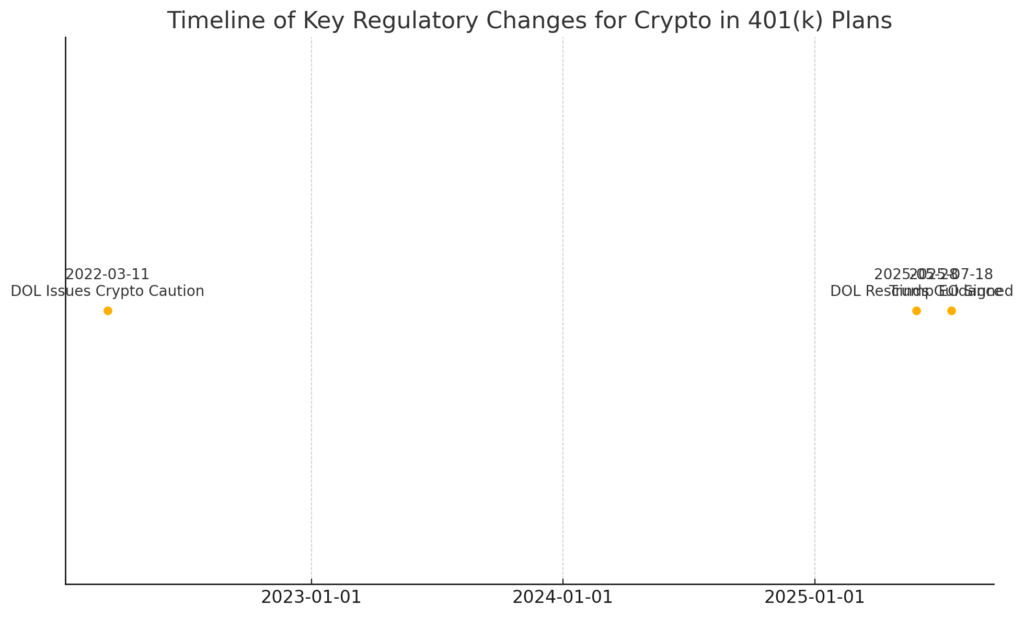
Main Points:
- Executive Order Expands Alternatives: President Trump signed an order on July 18, 2025, opening the $9 trillion U.S. retirement market—primarily traditional 401(k) plans—to alternative assets including cryptocurrencies, gold, and private equity.
- Regulatory Rollback: The U.S. Department of Labor formally rescinded its “extreme care” guidance from March 11, 2022, which had discouraged fiduciaries from adding crypto; this repeal took effect May 28, 2025.
- Market Impact: Major private capital firms like Blackstone, Apollo, and BlackRock stand to benefit by offering retirement‐plan versions of their alternative‐asset funds, potentially attracting hundreds of billions of dollars .
- Fiduciary and Legal Considerations: Critics warn that higher fees, limited liquidity, and valuation opacity in alternative assets could expose plan sponsors to increased risks and legal liabilities.
- Broader Trend in Crypto Adoption: This move aligns with global institutional interest in digital assets—recent launches of ETH ETFs, stablecoin yield products, and corporate treasury allocations illustrate growing mainstream momentum.
Introduction
On July 18, 2025, President Donald Trump signed a landmark executive order directing federal regulators to remove barriers preventing 401(k) retirement plans from investing in alternative asset classes, including cryptocurrencies, gold, and private equity. The order targets a market worth approximately $9 trillion—traditionally dominated by mutual funds invested in stocks and bonds—and instructs the Department of Labor (DOL) and Securities and Exchange Commission (SEC) to develop a safe‐harbor framework for plan administrators. This article explores the background, expected market impacts, legal considerations, and broader trends spurring institutional adoption of digital assets.
Historical Regulatory Context
2022 “Extreme Care” Guidance
On March 11, 2022, under the Biden administration, the DOL issued Compliance Assistance Release 2022-01, warning fiduciaries to exercise “extreme care” before adding crypto to 401(k) investment menus. The guidance cited concerns over volatility, custody risks, valuation challenges, and the inexperience of plan participants.
2025 Repeal and Return to Neutrality
On May 28, 2025, the DOL rescinded the “extreme care” language, affirming that fiduciary duties under ERISA require ordinary prudence and loyalty without heightened crypto-specific standards. Labor Secretary Lori Chavez-DeRemer criticized the 2022 guidance as “bureaucratic overreach” that tilted the scales against fiduciary discretion.
July 2025 Executive Order
Building on the repeal, the July 18, 2025, order directs regulators to:
- Identify and eliminate residual legal and operational barriers to alternative‐asset inclusion.
- Draft model safe‐harbor provisions to protect plan sponsors from fiduciary liability.
- Facilitate the listing of qualified alternative‐asset options within 401(k) menus.

Market Opportunity and Reactions
Private Capital Managers
Firms like Blackstone, Apollo Global Management, and BlackRock have already formed specialized teams to package private equity and real‐asset strategies for defined‐contribution plans. They project inflows in the high hundreds of billions, as retail retirement accounts gain access to strategies once reserved for institutional investors.
Crypto Entry Points
Cryptocurrency asset managers and exchanges are developing 401(k)‐compatible products, ranging from Bitcoin and Ether ETF wrappers to yield‐bearing stablecoin funds. Market participants note that younger plan participants are particularly drawn to crypto’s growth potential.
Concerns Over Fees and Liquidity
Opponents highlight that alternative assets typically carry management fees in the 1 – 2 percent range—far above the 0.1 – 0.5 percent typical of broad‐market index funds—and may impose lock‑up periods restricting participant redemptions, raising liquidity and valuation challenges.
Practical Implementation Challenges
- Valuation: Establishing daily or periodic net‐asset values (NAV) for private equity and crypto funds will demand robust pricing services.
- Custody and Recordkeeping: Fiduciaries must partner with qualified custodians capable of safeguarding digital assets and providing accurate participant statements.
- Education and Disclosure: Plan sponsors will need to supply clear disclosures and participant education materials to explain the risks and mechanics of alternative investments.
- Plan Design and Vendor Selection: Retirement committees must revise plan documents and potentially select new recordkeepers or fund providers offering alternative asset windows.
Broader Trends in Digital Asset Adoption
- ETF Proliferation: In 2025 alone, multiple spot Bitcoin and Ethereum ETFs launched in the U.S., crossing $25 billion in assets under management by May.
- Stablecoin Institutional Yield: Major custodians now offer institutional stablecoin lending, providing yields 3 – 6 percent above traditional money‐market instruments.
- Corporate Treasury: Companies such as MicroStrategy and Tesla have allocated portions of their cash reserves to Bitcoin, signaling growing corporate confidence.
- Regulatory Developments: The passage of the CLARITY Act and the GENIUS Act in mid‑2025 clarified SEC and CFTC jurisdiction and imposed new audit requirements on stablecoin issuers, respectively.
Conclusion
President Trump’s executive order marks a significant inflection point in U.S. retirement investing, potentially unlocking a $9 trillion pool of capital for alternative assets, including digital currencies. While the move stands to benefit asset managers and meet growing demand among self‑directed investors, plan sponsors must carefully navigate fiduciary duties, valuation, custody, and fee structures to ensure participants’ best interests remain paramount. As ETFs, stablecoin yield products, and corporate adoption continue to mature, this policy shift may catalyze the full integration of digital assets into mainstream retirement portfolios.

